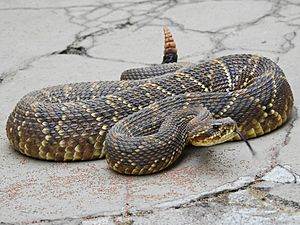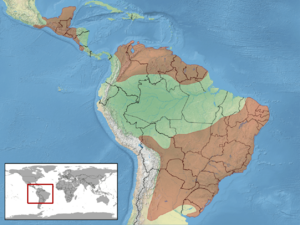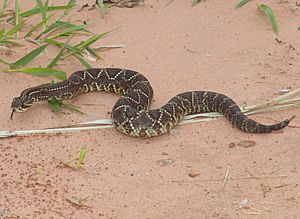South American rattlesnake facts for kids
Quick facts for kids South American rattlesnake |
|
|---|---|
 |
|
| South American rattlesnake (Crotalus durissus terrificus) | |
| Conservation status | |
| Scientific classification | |
| Genus: |
Crotalus
|
| Species: |
durissus
|
 |
|
| Synonyms | |
|
|
The Crotalus durissus, also known as the South American rattlesnake, is a very venomous pit viper species. It lives in South America. This snake is the most widespread rattlesnake in its group. Scientists currently recognize seven different types, called subspecies.
Contents
- Snake Families: Understanding Subspecies
- What Does the South American Rattlesnake Look Like?
- How Does the South American Rattlesnake Behave?
- Reproduction and Life Cycle
- What Does the South American Rattlesnake Eat?
- Common Names for the Snake
- Where Does the South American Rattlesnake Live?
- What Kind of Places Does It Like to Live In?
- Understanding the Venom
- See also
Snake Families: Understanding Subspecies
Scientists group living things into families and types. This helps them understand how different animals are related. The South American rattlesnake has several subspecies. These are like different versions of the same snake species. They might have small differences in looks or where they live.
| Subspecies | Taxon author | Common name | Geographic range |
|---|---|---|---|
| C. d. cumanensis | Humboldt, 1833 | Venezuelan rattlesnake | Dry lowlands of Venezuela and Colombia |
| C. d. durissus | Linnaeus, 1758 | South American rattlesnake | Coastal savannas of Guyana, French Guiana and Suriname |
| C. d. marajoensis | Hoge, 1966 | Marajon rattlesnake | Known only from Marajo Island, Para State, Brazil |
| C. d. maricelae | García Pérez, 1995 | Bolson arido de Lagunillas, Estado Mérida, Venezuela | |
| C. d. ruruima | Hoge, 1966 | Known from the slopes of Mount Roraima and Mount Cariman-Perú in Venezuela (Bolívar). A few specimens have been recorded in Brazil (Roraima). | |
| C. d. terrificus | (Laurenti, 1768) | Cascavel | Brazil south of the Amazonian forests, extreme southeastern Peru, Bolivia, Paraguay, Uruguay, northern Argentina |
| C. d. trigonicus | Harris & Simmons, 1978 | Inland savannas of Guyana |
What Does the South American Rattlesnake Look Like?
This is a large rattlesnake found in the Americas. It can grow to about 1.5 meters (5 feet) long. Some rare ones can even reach 1.9 meters (6.2 feet).
It has two clear stripes that start near its head. The color between these stripes is usually lighter than the stripes themselves. The snake's body color and pattern can change a lot. Most have diamond or rhombic (diamond-shaped) spots on their back. These spots are darker than the rest of their body.
The snake's head often has a dark brown bar on top. There is also a dark band behind its eyes. The belly can be white or yellowish. It might have light gray spots that get darker towards the tail. The tail is usually gray with dark, faint bands.
How Does the South American Rattlesnake Behave?
This snake is most active when the sun goes down and in the early morning. It usually does not act aggressively towards people. However, it can bite if it feels trapped or threatened.
Reproduction and Life Cycle
South American rattlesnakes have a yearly breeding time. Males compete to find females around the end of summer. The baby snakes are born the next spring or summer.
These snakes give birth to live young, usually 4 to 8 babies at a time. This is called ovoviviparous reproduction. In some parts of Brazil, like Roraima, it's been reported that pregnancy lasts about 5 months. They can give birth to up to 14 young.
What Does the South American Rattlesnake Eat?
This snake mainly eats rodents. Rodents are common in most areas where these snakes live, so they are an easy food source. In some places, the snake also eats lizards from the Teiidae family.
Common Names for the Snake
People call this snake by many names. Some common names include:
- South American rattlesnake
- Tropical rattler
- Tropical rattlesnake
- Neotropical rattlesnake
- Guiana rattlesnake (this name was used for a specific subspecies before)
In Spanish, it's called víbora de cascabel, cascabel, or cascabela. In Portuguese, it's known as cascavel. In Suriname, people call it Sakasneki.
Where Does the South American Rattlesnake Live?
Crotalus durissus lives in South America. You won't find it in the Andes Mountains. Its home range is spread out, with many separate groups in northern South America. This includes countries like Colombia, Venezuela, Guyana, Suriname, French Guiana, and northern Brazil.
It also lives in eastern Brazil, going south to southeastern Peru, Bolivia, Paraguay, Uruguay, and northern Argentina. In Argentina, it's found in many provinces like Catamarca and Córdoba. It can also be found on some islands in the Caribbean, such as Aruba.
What Kind of Places Does It Like to Live In?
This snake prefers savanna areas and places that are semi-arid. Semi-arid means they are somewhat dry. It has been seen in dry, scrubby areas near the coast. It also lives in grasslands and thorny scrublands. You can find it in forests where trees lose their leaves in certain seasons. In the Chaco region of Paraguay, it likes drier, sandier spots.
Understanding the Venom

The venom of the South American rattlesnake is very powerful. It is different from the venom of rattlesnakes found in North America. This is because it contains special substances called neurotoxins. These neurotoxins can cause problems with the nervous system.
If a person is bitten, they might experience:
- Trouble seeing or even temporary blindness
- Hearing problems
- Drooping eyelids (ptosis)
- Weakness or paralysis in muscles, especially in the neck
- Difficulty breathing, which can be very serious
Sometimes, the eye problems can lead to lasting blindness. The venom can also damage muscles, causing body aches and pain. When muscles are damaged, a substance called myoglobin can be released. This can make urine appear dark.
Other serious issues can include problems with blood clotting and bleeding. Blood pressure might drop, leading to shock. Kidney failure is a main cause of death from these bites. It is very important to get medical help right away if bitten. Without special treatment, the risk of death is high. With proper treatment, the chances of recovery are much better.
Some studies show that rattlesnakes in certain areas, like Roraima, Brazil, can have different types of venom. One type, called "yellow venom," mainly affects the nervous system. It can cause paralysis, kidney problems, and breathing issues. It also causes muscle pain and dark urine. Another type, called "white venom," causes bleeding.
See also
 In Spanish: Cascabel tropical para niños
In Spanish: Cascabel tropical para niños


